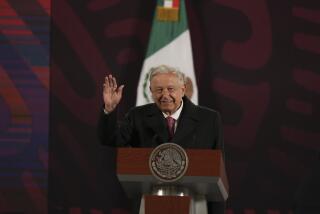Luxurious Rooms, Gallons of Expensive Perfumes - Fall Reveals a Private World in Palace
- Share via
MANILA —
The Marcos family’s once-private living chambers in the Malacanang presidential palace were testimony Tuesday night to the haste of a fleeing Third World dictator.
The parquet floors of President Ferdinand E. Marcos’ quarters were strewn with private papers and decrees. Emptied drawers stood half-open.
The mirrored dressing room of First Lady Imelda Marcos was still filled with hundreds of her costly silk dresses and large wicker baskets overflowing with scented soaps from around the world.
Dozens of quart- and gallon-size bottles of the most expensive French perfumes still scented the room more than two hours after their owner, with husband and family, had fled a nation that no longer wanted them after two decades of rule.
Touring the most intimate corners of a palace that many Filipinos had came to view as a symbol of their oppression, a Times correspondent found that the Marcoses had fled so hastily that they abandoned scores of precious family mementoes--a six-foot oil painting of Marcos half nude in a Philippine jungle, photographs of Marcos and the First Lady embracing, videotapes of Marcos family gatherings and of a private visit between Imelda Marcos and Nancy Reagan.
They also left behind a lavish, half-eaten meal with the family’s silver service, a half-dozen wide-screen television sets, costly stereo units, a double freezer stuffed with imported American steaks and a 10-foot-high closet packed with the First Lady’s nightgowns.
Beside Imelda Marcos’ 12-foot-wide bed was a half-eaten banana.
One thing that the First Lady did take with her, though, was her famed jewelry collection. Two large jewelry display cases were empty, and the floors of her bedroom were strewn with empty jewelry boxes.
There were many other signs in the First Family’s private quarters--which had been off limits to journalists for two decades--of the lavish life style that had so alienated the Marcoses from so many of their countrymen as the nation’s economy went from crisis to crisis.
The floors of every room were covered with valuable rugs from Afghanistan, China, Iran and India. Chinese silk prints graced the walls. Crystal statuettes stood atop rosewood coffee tables, and Marcos’ bedroom contained two wide-screen television sets, sophisticated exercise machines and even a five-foot-long, remote-controlled toy car.
15-foot Sunken Bath
Imelda Marcos’ private bathroom was equipped with a 15-foot-square sunken bathtub, mirrored ceilings, gallon bottles of a custom-made French perfume called First Lady and no fewer than five Italian bathrobes.
And her husband’s gymnasium-sized bedroom was a mute statement of a chronic condition of ill health that the president had always denied.
Beside Marcos’ king-size bed was a specially fitted hospital bed connected to an oxygen machine and an intravenous bottle containing an unlabeled clear liquid. Elsewhere in the room stood a sophisticated piece of medical equipment called the “Centurion Magnotherapy,” which a brochure explained was designed to treat chronic and degenerative illnesses of the heart, lungs and kidneys.
The president’s obsession with illness was obvious elsewhere in the palace. On the ground floor, Marcos had outfitted by far the most sophisticated operating theater and hospital emergency room in all of the Philippines.
Buckminster Fuller Book
There were also many signs in the palace of the personality traits of Marcos and his wife. Books that Marcos had left lying out included “Operating Manual for Spaceship Earth” by Buckminster Fuller, “The Great Book of Jewels” and “Self Learning Course on Goat Raising.”
Imelda Marcos had filled every inch of space on the several oversized, imported grand pianos in her chambers with photographs of her, without her husband, greeting leaders from virtually every nation of the world.
Throughout the rooms, though, there were also ample hints of the crisis that forced the exile of a man who had vowed never to leave his palace alive.
On a second-floor balcony, near the spot where Marcos had been sworn in for another six-year term at noon Tuesday, was a large blackboard depicting a detailed map of Manila’s military Camp Crame, the revolutionary headquarters of Marcos’ former defense minister, Juan Ponce Enrile, and his former deputy armed forces chief of staff, Lt. Gen. Fidel V. Ramos.
Notes on Men, Arms
Beside the map were notes listing the rebels’ possible strength in men and arms.
In a pile of documents stamped “Top Secret and Confidential,” near the president’s bed, was a letter from Ramos to Marcos dated Feb. 19, three days before Ramos joined Enrile in defying the Marcos regime.
The letter warned the president that a recent flurry of “midnight appointments or assignments” within top military ranks by Marcos’ chief of staff, Gen. Fabian C. Ver, “is not good for the armed forces of the Philippines.”
Near the stack of documents, though, was perhaps the most apt symbol of all for a leader who vowed on national television just 24 hours before he fled that he would never resign, never flee and would instead stand and fight “like a good soldier.”
Beside the two pillows on Marcos’ unmade bed was one more souvenir that the president had left behind--his World War II army helmet.
More to Read
Sign up for Essential California
The most important California stories and recommendations in your inbox every morning.
You may occasionally receive promotional content from the Los Angeles Times.










